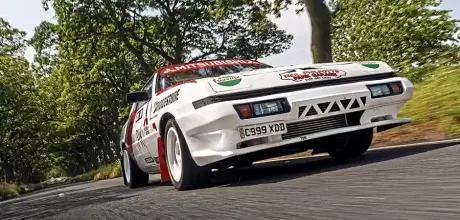1986 Ralliart Group A Mitsubishi Starion
This was one of the first Ralliart cars built. We drive it, and meet two other examples that prove the Mitsubishi Starion is an unsung motor sport hero.
Words SAM DAWSON
Photography JONATHAN JACOB
Origin Of A Species
How the Ralliart dynasty began with the Mitsubishi Starion
The Evo story began here: driving a Ralliart Group A Mitsubishi Starion
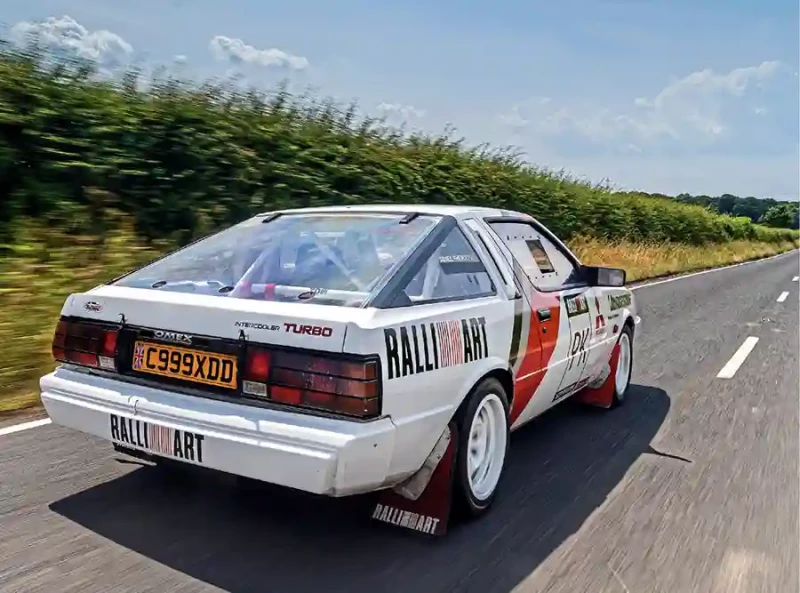
A gravelly, gargling four-cylinder cannonade echoes off the canyon-like walls of a man-made cutting slicing through the forested Wirral, just West of Birkenhead. Hikers out for the afternoon peer between the brambles towards the source of the noise, and catch a glimpse of the culprit. Angular and brutal, nose like a chisel, daubed in red-and-white warpaint and proudly carrying a familiar logo on its rear bumper: Ralliart. A works-prepared Mitsubishi on the loose, its sheer primary-coloured boldness at odds with the natural world around it, is one of the most distinctive sights in the rally world.
‘You can draw a line of succession all the way back to it from the last Ralliart Lancer Evo X’
But this isn’t a Galant VR4 or Lancer Evolution, the cars that brought the Mitsubishi marque glory. It’s a Starion. A car better known for the (incorrect) jokes surrounding how its name was derived and its image as the epitome of Eighties medallion-man cringe rather than serious motor sport credibility. And yet, as we will discover, it’s far more credible than its reputation would have it. This car was one of the first created under the Ralliart regime, and it shares garage space with two other Starions that between them marked origin points for two other garagistes using Japanese machinery as a basis with which to create new breeds of Brit-fettled performance car. Without the Starion, would they be where they are today?
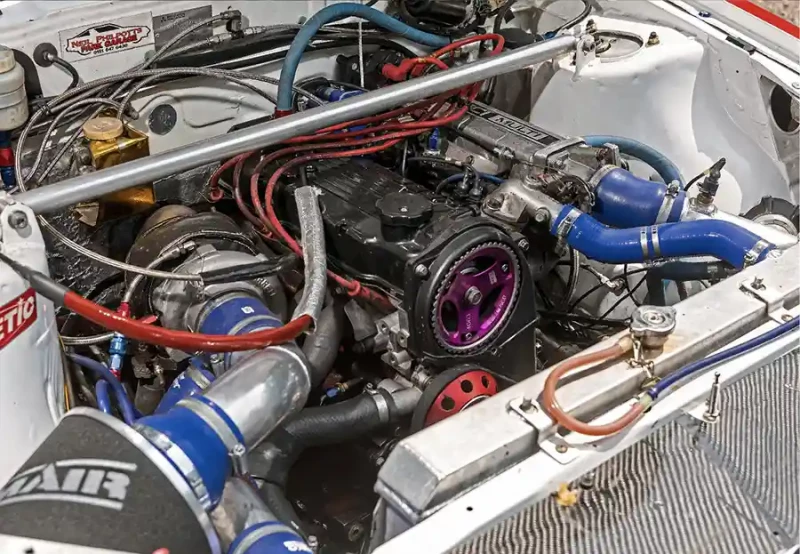
Clamped into this Group A rally car’s five-point harness, I don’t have time to muse on alternative histories. This particular car is currently fitted with a sequential gearshift, a deviation from its period specification left in place after a recent Libreclass rally, but owner Neil Philpotts bolts the original back in when it contests Historics. The original clutch picks up the drive smoothly so long as you hold at least 2000rpm while shifting. Lift off, the plates mesh, and the scream of the gearbox dominates as the rear tyres dig into the tarmac and the Starion rockets off the line. The engine’s snarl is so completely obliterated by the whirling gear clusters that I have to rely on the tachometer alone to know when to stab the clutch, reach for the lever and clank it backwards to shift up. Then the tyres scrabble on the uptake and the process starts all over again, faster and faster each time. Until it’s time to brake. The pedal has near-zero travel and feels rock-hard underfoot, but I lean on it and the stopping power comes slamming through my shoulder-straps.
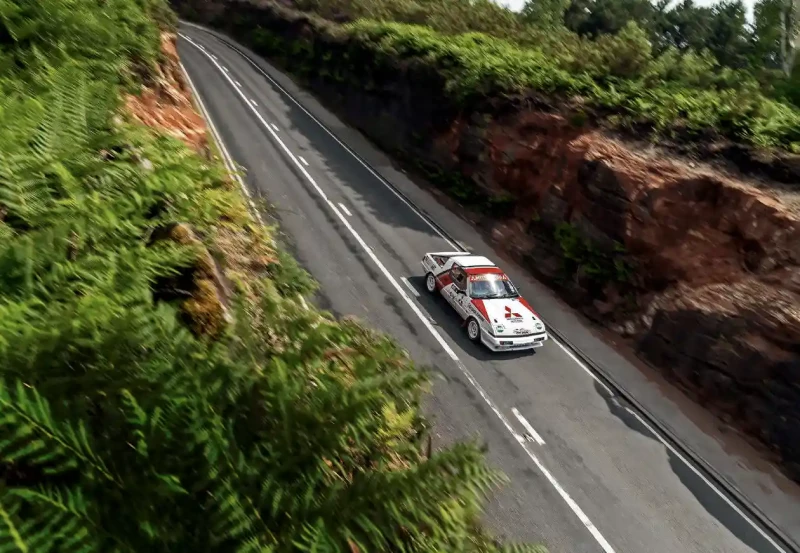
The wheel is thrust into my chest, like that of a Fifties sports car, rather than some laid-back Eighties cruising coupé with power steering. But rather than being like that to assist in shoulder-barging heft, the worm-and-roller setup is actually nimble and light, rather like that of an Alfa Romeo Duetto Spider’s. The Starion’s wide front tyres rob it of feel though. Pitch it into a corner at speed and the Starion adopts friendly, progressive roll angles. The damping is smooth, and you can lean on it into corners, feeling its attitude settle even into remarkably tight bends. Complexes of country-lane S-bends are satisfying to knit together in this machine.
It puts it somewhat at odds with the road car it’s based on. Give a standard Starion a bootful of throttle out of a tight bend and you’ll soon be reining in its oversteer on its numb-feeling wheel, chuckling at its wayward antics while wondering whether those Eighties magazine road-testers who poked fun at its name had a point when they said it was a bit of a crude device. In rally spec, a limited-slip differential has the car carving a neat arc instead, making it easier to press on.
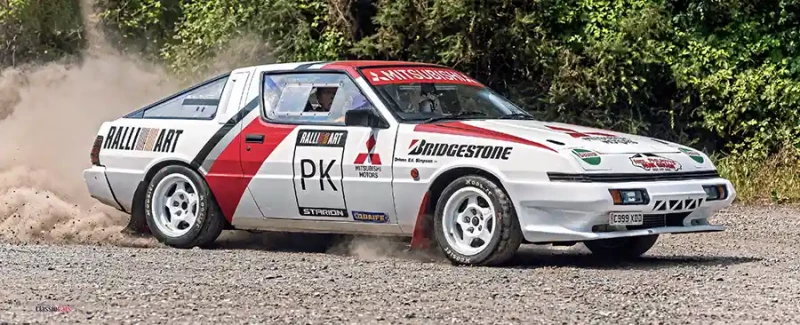
Driving this Ralliart car and thinking about it in the context of its creation makes me want the world to reconsider the Starion. It was the first example of a mass-produced intercooled, fuel-injected turbocharged car. The G63B engine featured contrarotating balancer shafts for smoothness too, as you’d find on a Lotus, Maserati or Porsche of the period.
‘Pitch it into a corner and it adopts friendly, progressive roll angles’
And yet, at £11,734, the Starion undercut the likes of the Opel Monza and Vauxhall Royale, while its 7.5-second 0-60 sprint time and top speed of 135mph would have it nibbling at the heels of the Ferrari 308GTB. It was comfortably faster than the Porsche 944 – in fact its performance was practically on a par with the £21,827 928. ‘Should ruffle some feathers at Porsche, Alfa and BMW,’ noted CAR in 1982. Wildly fast turbo coupés weren’t merely par for the Japanese course back then either. When the Starion was unleashed on the world, the Prelude, Celica, Supra and 280ZX were still hefty, gadgety cruisers. In retrospect, the Starion seems like the origin point for that breed of mass-market, vaguely-affordable peoples’ supercar Japan would go on to make its own. The theme which would culminate in the Nineties with twin-turbo Toyota Supra, Nissan 300ZX and Mitsubishi GTO, capable of embarrassing 911s and laden with Italian-inspired styling cues, yet carrying real-world price tags and boasting minicab reliability.
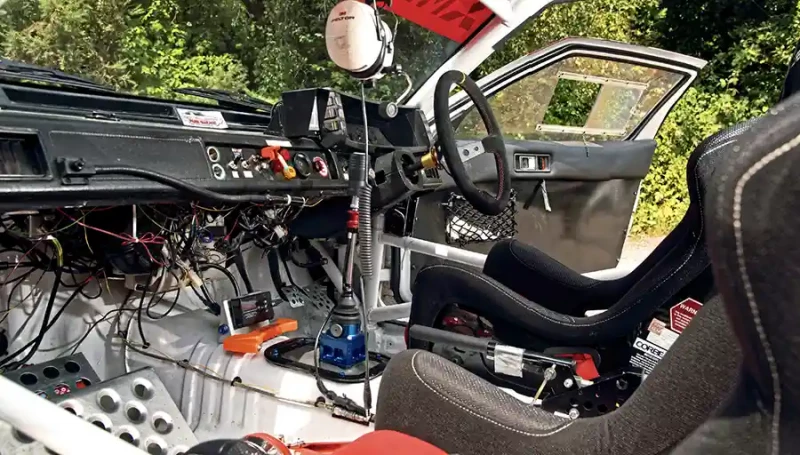
By that point, there was a sense among some enthusiasts that there was something almost superfluous about established expensive supercars. Traditionalists would counter that, claiming the Japanese cars had no heritage, that they weren’t born out of the passion and pain of motor sport. But they would be wrong. This car is living proof of that.
Former Rootes Group works rally driver Andrew Cowan had campaigned Mitsubishis since 1972, succeeding in epic tests of endurance in the Southern Hemisphere. So when the Japanese manufacturer wanted to refocus on stage rallying and the World Championship, it turned to Cowan to mastermind it. He established Andrew Cowan Motor Sports in Rugby in 1983, formalised as Mitsubishi Ralliart Europe in 1984. Ever-canny with his relatively meagre budget from head office, Cowan started developing a Group A conversion kit for the Starion, which could be fitted at an approved network of Ralliart dealers.
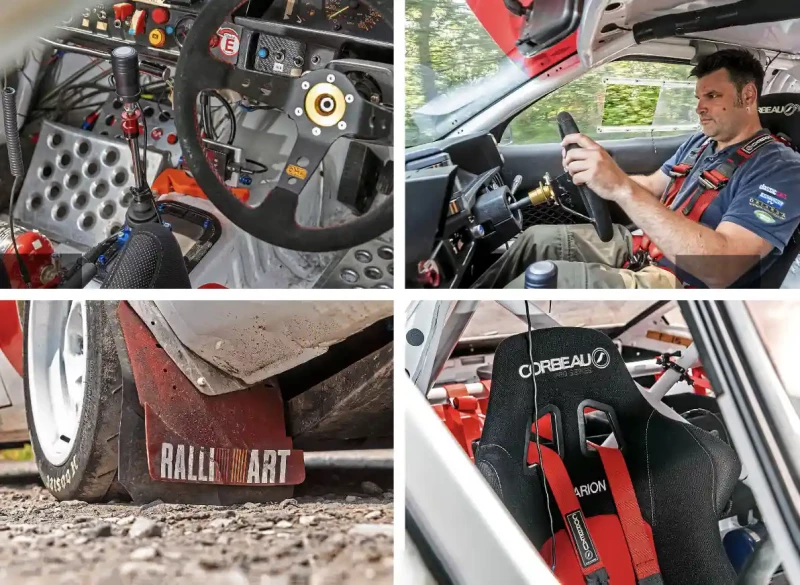
However, in those early days, Cowan, Mitsubishi and the rally world in general were understandably preoccupied with the Group B class. The Ralliart outfit’s first clean-sheet project was a prototype four-wheel drive Starion co-created by ex-Audi Quattro engineer Alan Wilkinson. It scored prototype-class wins on the 1983 Paris-Dakar and 1984 Milles Pistes rallies, but before a 200-car production run could be readied for the 1986 RAC Rally ahead of a proper assault on the 1987 World Rally Championship, Group B was banned.
‘The Starion feels like the origin point for the mass-market, vaguely-affordable peoples’ supercars that Japan would make its own’
But unlike so many Group Bs, Ralliart’s four-wheel-drive Starion was front-engined and based on the production car. Lessons learnt extracting 350bhp from the ‘Sirius Dash’ triple-valve evolution of the single overhead-cam engine and strengthening the X-Trac transmission to cope with the torque filtered down to the Ralliart Starion Group A kits. As did the suspension, brakes and fuel tank.
This car was intended for the 1985 RAC Rally, but when the flag fell on that event it was still incomplete. The reason isn’t known, but it’s possible that Ralliart Europe’s preoccupation with its Group B Starion delayed work on the Group A cars. A trio of works-backed Starions built by Tusk Engineering in Japan contested the Group A class in that rally instead.
This car was finally completed on 16 March 1986, just eight days after the fatal Rallye de Portugal, where Joaquim Santos’s Ford RS200 went into the crowd at full speed, effectively sparking the beginning of the end for Group B. A month later, after the deaths of Henri Toivonen and Sergio Cresto on the Tour de Corse, it was banned. The WRC’s focus switched to Group A, where the devastating effectiveness of the Mazda 323 4WD and Audi Coupé Quattro was demonstrating that any front-runners would need all wheels driven too. In 1987, the Lancia Delta HF 4WD suddenly rendered all rivals obsolete.
This didn’t phase Ralliart. The four-wheel drive knowhow derived from the Group B project allied to the production-based Group A Starion engine resulted in the Galant VR4 by the end of 1988. In the interim, Wilkinson set up a team with Pentti Airikkala, running a Starion sponsored by Safety Devices in the 1988 British Rally Championship and winning the Cartel International and Welsh Rallies. By the end of the season though, Airikkala was driving a Delta.
But in retrospect, you can draw a line of succession all the way back from the last Ralliart-prepared Mitsubishi Lancer Evolution X to this Group A Starion, left directionless and with an uncertain future even as it was completed. Embracing Cowan’s ethos of modifying production-class cars via a dealer network, even in the silhouette-car WRC era from 1997 onwards, resulted in four consecutive World Rally Championship titles from 1996 to 1999.
As motor sport dynasties go, the Ralliart Starions sired something easily comparable to those thoroughbreds that graced so many bedroom walls in the Eighties. This Mitsubishi didn’t merely aspire to be a supercar – it was one.
TECHNICAL DATA 1986 Ralliart Group A Mitsubishi Starion
- Engine 2555cc in-line four-cylinder, sohc, Hitachi ECI electronic fuel injection system, Mitsubishi TD05H-14G turbocharger
- Max Power 300bhp @ 6500rpm
- Max Torque 300lb ft @ 4500rpm
- Transmission Five-speed manual, rear-wheel drive
- Steering Worm and roller
- Suspension Front: independent, MacPherson struts, coil springs, telescopic dampers, anti-roll bar. Rear: independent, semi-trailing arms, lateral links, coil springs, telescopic dampers, anti-roll bar
- Brakes Servo-assisted discs front and rear
- Performance Top speed: 120mph
- Acceleration 0-60mph: <5.0sec (est)
- Weight 1100kg
- Fuel consumption n/a
- Cost new n/a
- Value now £80,000
Worm-and-roller steering light but precise One of the best known names in Group A rallying Group A cars supplied to dealers as kits Temporary fitment of sequential shift. First engine to combine turbo, EFI & intercooler.Built for the ‘85 RAC, this car has always rallied. In here, gearbox is louder than engine at speed.
OWNING A RALLY STARION
‘I got into Starions because Ford Sierra Cosworths were getting too expensive to insure in 1990, and the Mitsubishis were going cheap,’ says owner and classic Mitsubishi specialist Neil Philpotts. ‘I bought this car from rally driver Ed Simpson 15 years ago. The first thing I noticed about it was the plumbed-in Ralliart fuel tank, FIA date-stamped from 1985. It was placed on the reserve entry list for the 1985 RAC Rally, but it wasn’t finished in time. However where it fits in the history of Ralliart and Mitsubishi because of its build date makes it fascinating.
‘I use it as intended though, rallying it as far afield as Majorca. I also race Starions too. After crashing one at Devil’s Elbow at Mallory Park, I bought Craig Davis’s ex-Bathurst Production Touring Car Championship car from Australia. And as you’ll see, I’ve acquired two special racing Starions, although it’ll be a while before they’re back on the track…’


